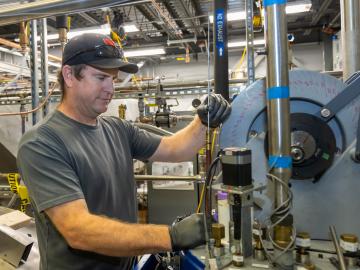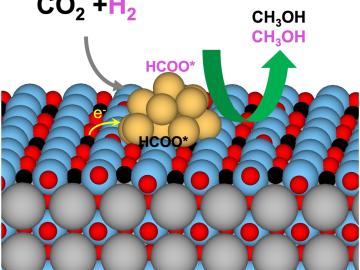Filter News
Area of Research
- Advanced Manufacturing (29)
- Biological Systems (16)
- Biology and Environment (116)
- Biology and Soft Matter (1)
- Building Technologies (10)
- Chemical and Engineering Materials (1)
- Chemistry and Physics at Interfaces (5)
- Clean Energy (397)
- Climate and Environmental Systems (6)
- Computational Biology (5)
- Computational Engineering (4)
- Computer Science (14)
- Data (1)
- Electricity and Smart Grid (1)
- Energy Frontier Research Centers (8)
- Energy Sciences (4)
- Fossil Energy (3)
- Fuel Cycle Science and Technology (1)
- Functional Materials for Energy (7)
- Fusion and Fission (28)
- Fusion Energy (10)
- Geographic Information Science and Technology (2)
- Isotope Development and Production (3)
- Isotopes (22)
- Materials (313)
- Materials Characterization (2)
- Materials for Computing (23)
- Materials Synthesis from Atoms to Systems (6)
- Materials Under Extremes (6)
- Mathematics (1)
- National Security (48)
- Neutron Data Analysis and Visualization (2)
- Neutron Science (120)
- Nuclear Science and Technology (47)
- Nuclear Systems Modeling, Simulation and Validation (3)
- Nuclear Systems Technology (1)
- Quantum Condensed Matter (1)
- Quantum information Science (4)
- Reactor Technology (1)
- Renewable Energy (3)
- Sensors and Controls (4)
- Supercomputing (157)
- Transportation Systems (7)
News Type
Date
News Topics
- 3-D Printing/Advanced Manufacturing (85)
- Advanced Reactors (25)
- Artificial Intelligence (44)
- Big Data (28)
- Bioenergy (55)
- Biology (59)
- Biomedical (36)
- Biotechnology (13)
- Buildings (39)
- Chemical Sciences (44)
- Clean Water (20)
- Climate Change (57)
- Composites (20)
- Computer Science (108)
- Coronavirus (34)
- Critical Materials (24)
- Cybersecurity (26)
- Decarbonization (39)
- Education (3)
- Element Discovery (1)
- Energy Storage (86)
- Environment (115)
- Exascale Computing (12)
- Fossil Energy (1)
- Frontier (17)
- Fusion (30)
- Grid (42)
- High-Performance Computing (45)
- Hydropower (8)
- Irradiation (2)
- Isotopes (30)
- ITER (6)
- Machine Learning (27)
- Materials (100)
- Materials Science (95)
- Mathematics (4)
- Mercury (9)
- Microscopy (36)
- Molten Salt (7)
- Nanotechnology (44)
- National Security (35)
- Net Zero (6)
- Neutron Science (84)
- Nuclear Energy (57)
- Partnerships (27)
- Physics (45)
- Polymers (25)
- Quantum Computing (14)
- Quantum Science (38)
- Renewable Energy (1)
- Security (18)
- Simulation (18)
- Space Exploration (13)
- Statistics (3)
- Summit (28)
- Sustainable Energy (88)
- Transformational Challenge Reactor (4)
- Transportation (71)
Media Contacts

Associate Technician Sean Hollander is the keeper of the Fundamental Neutron Physics Beamline, which is operated by the Physics Division at the Spallation Neutron Source at ORNL, where scientists use neutrons to study all manner of matter.

ORNL scientists develop a sample holder that tumbles powdered photochemical materials within a neutron beamline — exposing more of the material to light for increased photo-activation and better photochemistry data capture.

ORNL researchers used electron-beam additive manufacturing to 3D-print the first complex, defect-free tungsten parts with complex geometries.

A technology developed by Oak Ridge National Laboratory works to keep food refrigerated with phase change materials, or PCMs, while reducing carbon emissions by 30%.

Scientists have uncovered the properties of a rare earth element that was first discovered 80 years ago at the very same laboratory, opening a new pathway for the exploration of elements critical in modern technology, from medicine to space travel.

A team of scientists led by ORNL found an unconventional way to improve catalysts made of more than one material. The solution demonstrates a path to designing catalysts with greater activity, selectivity and stability.

Researchers at ORNL are developing battery technologies to fight climate change in two ways, by expanding the use of renewable energy and capturing airborne carbon dioxide.

ORNL researchers have produced the most comprehensive power outage dataset ever compiled for the United States. This dataset, showing electricity outages from 2014-22 in the 50 U.S. states, Washington D.C. and Puerto Rico, details outages at 15-minute intervals for up to 92% of customers for the eight-year period.

Mohamad Zineddin hopes to establish an interdisciplinary center of excellence for nuclear security at ORNL, combining critical infrastructure assessment and protection, risk mitigation, leadership in nuclear security, education and training, nuclear security culture and resilience strategies and techniques.

Howard Wilson explores how to accelerate the delivery of fusion energy as Fusion Pilot Plant R&D lead at ORNL. Wilson envisions a fusion hub with ORNL at the center, bringing together the lab's unique expertise and capabilities with domestic and international partnerships to realize the potential of fusion energy.




